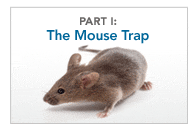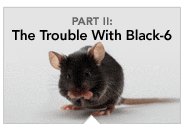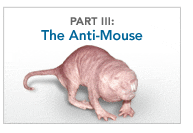The Trouble With Black-6
A tiny alcoholic takes over the lab.
There's a warehouse about 20 minutes north of Boston, in a minor maze of buildings behind a barbed-wire fence. Ventilation ducts crisscross the ceiling over stacks of polyurethane pods, where half a million mice burrow in sterilized aspen, or stand up on their hind legs chewing irradiated food nuggets through wire-top lids. Up and down the aisles at the world's leading supplier of research animals, workers in solid-color scrubs—turquoise, purple, coral—stand on rolling stepladders with their arms inserted into the sleeves of one germ-free bubble or another, faces close up to the bulging plastic, manipulating the mice or moving them from cage to cage as if they were playing arcade games.
It takes five days for Charles River Laboratories to truck a crate of these animals from here to Seattle, and there are five dozen more facilities like this one around the world, with thousands of employees in 17 countries, shipping out millions of animals and earning some $700 million every year. The company sells research rodents in dozens of standard and specialized strains—mice, mostly, but also rats, and some rabbits, gerbils and hamsters, too. Their cheapest product, I'm told, is the CD-1 mouse, an all-purpose model for toxicology, aging, and oncology that goes for about $5. At the other end of the catalog are the custom-made mutants and the "preconditioned" models that have been surgically altered or otherwise seasoned for immediate use by the client. These cost as much as $400 each.
The best-selling animal, though—here and elsewhere—is a dark-coated, inbred mouse who's not too big and not too small, not too dumb and not too smart. He's called Black-6.
* * *
According to one estimate, distributors like Charles River and the scientists who buy from them have created at least 400 standard, inbred strains of mouse, and 200 inbred strains of rat. Yet one stands out from the rest as the model among models in biomedicine. If you want to set up a trading post for biology, a place where researchers from around the world can exchange and compare their data, then it helps to have a common coin—a stable currency that undergirds the system. In the global marketplace of discovery, the Black-6 mouse (more formally known as the "C57BL/6") serves as the U.S. dollar.
Almost 10 years ago, Nature magazine published the genome of the mouse—making it the second mammalian species after the human to have its DNA sequenced. But the researchers who conducted the work didn't use a field mouse caught from a barn, nor some unspecified laboratory strain. At a meeting held on Oct. 5, 2002, they debated their options, and decided by unanimous vote to sequence Black-6. It was on account of his "widespread use among the research community and favorable breeding characteristics," they wrote.
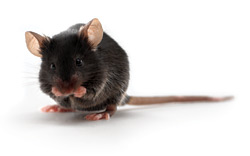
Courtesy of Charles River Laboratories International.
Yes, widespread: Just as mice and rats edged out the other lab animals in biomedicine, Black-6 has displaced the other mice and rats. Unless you had some reason to use one particular strain for your experiments—a nude mouse, let's say, for the screening of cancerous skin lesions, or the Bagg's Albino for its special role in the production of monoclonal antibodies—then Black-6 would be your fallback choice. The National Institute on Aging, for example, supplies 30,000 live, mature rodents every year to government-funded researchers around the country. A few years ago, Black-6 accounted for three-quarters of all the mice shipped out; now it makes up five-sixths.
Charles River won't break down its sales by strain, but a representative confirms that Black-6 mice outsell all others. A rival breeder estimates that Black-6 accounts for half to two-thirds of its orders. And the $900 million project to knock out and test the effects of every last gene in the mouse, to create a vast, public warehouse of these tens of thousands of mutant lines—that's being done in Black-6, too. When organizer Mark Moore says we have “a historic opportunity to systematically learn everything about a mammal for the first time,” he's not talking about just any mammal. He's talking about one that was created 90 years ago, when a mouse code-named C52 mounted one called C57 and deposited its semen in her reproductive tract with a waxy plug. Both were descended from a line of "fancy mice," sold as pets from a converted poultry farm in Granby, Mass., about 100 miles west of what now serves as the global headquarters for Charles River. That's where the Black-6 family tree took root.
"The more research you do on something, the more valuable it becomes," says geneticist and statistician Michael Festing, one of the world's experts on inbred lab mice. A format war hides in the history of biomedicine—a race to establish one mouse strain as the baseline. It didn't have to be Black-6, Festing tells me, but once the norm had been established, the costs of changing direction became prohibitive. "Really, it's just chance," he says. Use begat ubiquity.
So one dark-brown lab mouse came to stand in for every other lab mouse, just as the inbred lab mouse came to stand in for every other rodent, and the rodent came to stand in for dogs and cats and rabbits and rhesus monkeys, the standard models that themselves stood in for all Animalia. But where is Black-6 taking us? How much can we learn from a single mouse?
* * *
Jeff Mogil studies how rodents feel pain. He transforms their genes, constricts their nerves, inflames their paws and dips their tails in ice-cold water. He's a psychologist, a pharmacologist and a neuroscientist—one of many hoping to find new drugs for the one-third of the population whose trigger-happy neurons leave them in chronic discomfort. And like most of his colleagues, he's an expert—a connoisseur, even—of rats and mice.
Almost every pain researcher now uses one of two rodent breeds, Mogil tells me: Black-6 mice or Sprague Dawley rats. With each passing decade, the field has grown more devoted to this pair of animals, on the theory that at the molecular level, at least, mammalian species are more or less interchangeable—mouse to rat and rodent to ape. In 2008, Mogil conducted a survey of the PubMed database and found that rodent pain studies were about as popular as those of dogs, cats, rabbits, and horses through the 1970s. Thirty years later, they accounted for 92 percent of the research. "We're making this implicit assumption that things are the same in rat and mouse," he says, "and the reason we're making that assumption is because we're making another assumption—that if something is true in rats and mice, it's true in people."
In spring of the same year, Mogil decided to test the conventional wisdom among his colleagues, and so many others in biomedicine. If you look at all the genes that seem to matter for animal pain, how do they compare from one rodent to another? How similar are the pathologies for inbred mice and Sprague Dawley rats, at the level of their genes and proteins? "Frankly, we just published a paper that scared the hell out of me," Mogil says. According to his write-up in the August issue of Pain, many of the genes that were flagged as being relevant in one species didn't matter so much in the other. "Long story short: Things were completely different in the mouse."
The problem isn't limited to comparisons across rodent types. For a paper published in 1999, Mogil tested 11 different inbred mouse strains—albinos, white-bellied agoutis, dilute browns, Black-6—and ran them through a dozen standard tests of pain sensitivity. He found robust variation on every single measure. "That study made my career," he says. (He's now a named professor at McGill, and the recipient of copious research awards.) "At the time, the expectation was that all those strains were the same. Now everyone would say, 'Well, of course they're all different."
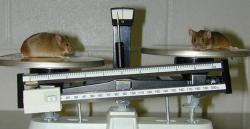
Courtesy of Lexicon Genetics Inc.
Amid all the data in that paper, one point stands out: No inbred line is more unusual in its response to painful stimuli, nor more of an oddball in the lab, than the one most favored by biologists. The Black-6 mouse turned out to be the greatest outlier in Mogil's tests, the ugly duckling. Put a few standard breeds of mice on a hot plate, and the Black-6 winces first. He's sensitive to cold, too, and analgesics don’t work on him as well as they might. "The geneticists have known for a long time that this is not an average mouse strain," says Mogil. "People don't want to deal with it. A lot of my career has been devoted to telling pain researchers that the simplifications they've made are too simple. The dirty little secret of C57BL/6 is that in a number of respects it's quite exceptional."
Mogil is the kind of guy who likes to tell "dirty little secrets." The peculiarities of Black-6 don't stop at the edge of the hot plate, he says. It's also one of the only strains of mice that consumes alcohol voluntarily, and it's prone to morphine addiction. There are other quirks, too, like its propensity for atherosclerosis and age-related hearing loss, and a strain-related fondness for nipping the hair off its cage-mates.
A few more facts fill out the profile of what's so often used as the "average" lab mouse. A recent study compared the immune systems of wild-caught mice to those of Black-6s raised in germ-free cages: Not surprisingly, the wild animals were more robust. Housing conditions on the factory floor leave most Black-6 mice (and other inbred strains) sedentary and overweight compared to their cousins in the field, and while a Black-6 can live for two or three years in captivity, it's typically studied or discarded within a few months of birth, to avoid unnecessary upkeep. Researchers also have a tendency to exclude female mice from testing—in Mogil's survey, almost four-fifths of pain studies were male-only—on the theory that estrus cycles might confound the data, or that including animals of both genders would increase the cost of their experiments.
There are plenty of good reasons to use Black-6, of course. He's a good breeder, he's not so hard to manage in his cage, and—in this era of the transgenic mouse—his dark coat helps out, too. To make a line of mutant mice, scientists mix a few stem cells from a light-furred breed called "129" into a Black-6 embryo, and then implant the embryo into a Black-6 female. When she gives birth, you can tell right away if the foreign DNA has taken hold: A transgenic pup grows up as a patchwork of 129 and Black-6, with tufts of cream or chinchilla fur sprouting through a coat of brownish-black. Nearly every transgenic line is made this way, with an altered gene from the 129 strain that’s diluted and back-crossed into a standard Black-6 background, like a swirl of peanut butter folded into a scoop of chocolate ice cream.
Yet it took a study like Mogil’s to point out a flaw that might have seemed obvious from the start: If you’ve chosen one breed of mouse—one flavor of ice cream—to serve as the vehicle for every genetic twist and the baseline for every study, then you’re stuck with all its idiosyncrasies. A standard is only as good as its quirks. The flavor of mouse that’s served up most often in the lab can be summed up in a single sentence: He's a teenaged, alcoholic couch potato with a weakened immune system, and he might be a little hard of hearing. For some applications, he's a sorry specimen.
* * *
The story of how one kind of mouse came to dominate the study of human health—and then, perhaps, to constrain it—begins a century ago, at a Gothic-revival building with flying buttresses and an iron weathervane across the street from Boston's Arnold Arboretum. It was there that a precocious Harvard undergraduate began a series of experiments on the genetics of purebred animals—mice that passed down every one of their traits from one generation to the next. His project would lead to the development of a major industry in breeding for profit, and promote an approach to science that relies on the essential similarity of all living things.
The Bussey Institution for Research in Applied Biology was teeming with biodiversity—"a veritable menagerie of rats, rabbits and guinea pigs," as one former member recalled, with a screech owl, a sparrow hawk, a tortoiseshell male cat, even a skunk. But Little's adviser, the geneticist William E. Castle, was interested in what all these animals had in common. Gregor Mendel's experiments on pea plants had just been rediscovered, and scientists now had the idea—described for the first time as genetics in 1906—that a single pattern of inheritance applied not only across the vegetable kingdom but to animals as well. Castle and his colleagues set to working out the finer details of this pattern by establishing some standard breeding lines—guinea pigs, rats, and rabbits, along with self-fertilized stalks of corn—in which an organism's particular genes could be traced and identified.

Little arrived at the Bussey in 1908, a square-headed track star still in his sophomore year, and started his own work with inbred mice. He purchased a few animals from the farm in Granby, and spent the next few years mating them brother-to-sister, for generation after generation, selecting only the most vigorous pups from each litter for another bout of incest. Eventually, the animals had become so entangled in their family ties as to be virtual clones of one another—a near-perfect line of identical twins, with identical parents and children, too.
In the first decade of the 20th century, no one knew how such experiments might play out. Some scientists worried that the process of inbreeding could never produce a viable stock, but Little's mice prospered in their pens at the Bussey, and went on to yield important early insights into the genetics of cancer. Within a few years, the inventor of the inbred mouse had an established career in academic science, dividing his time between the laboratory and the executive office, and serving as president of two major universities by the age of 37.
In 1929, he decided to create his own campus devoted to the mouse, and convinced a group of wealthy automobile executives to fund a research center at the edge of Acadia National Park in Bar Harbor, Maine. Little named the new laboratory after the head of a car company, Roscoe Jackson, and began applying the Detroit model to the manufacture of research organisms. His "thoroughbred" animals would become the raw material for biological research—as pure and reliable a subject of study, he promised, as the reagents on the shelf of a chemist. According to Karen Rader's excellent history of this project, Making Mice: Standardizing Animals for American Biomedical Research, the Jackson Lab began selling inbred mice in 1932, for 10 cents each plus the cost of delivery (with a money-back guarantee if the mice died in transit).
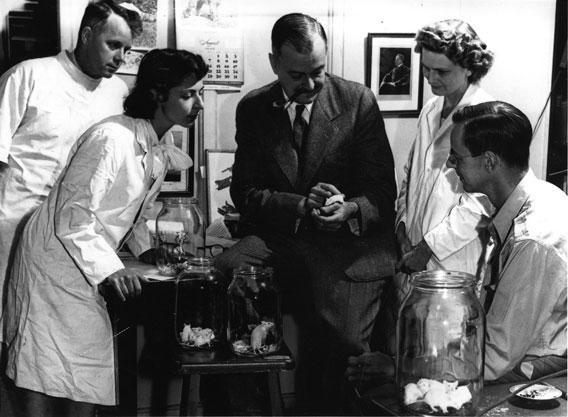
Courtesy of The Jackson Laboratory.
The first commercial catalog for lab mice listed nearly a dozen separate stocks for cancer research, some of which would become as standard as a screw thread. Among Little's early strains were the dark-furred C57BL mice that he'd created in 1921 using the Granby stock, and colonies of these made their way into nearly every lab at Bar Harbor. They had divided into at least 10 distinct sublines, remembered one of Little's early employees—but the most popular was No. 6.
* * *
Since the 1960s, the grounds at the Jackson Laboratory have been divided across the middle, with research and development on one side, closer to the pine-covered mountains, and mouse production on the other, in the direction of the harbor. The buildings are done up in the schlocky postmodernist style of 21st-century biotech—grids of turquoise glass and brick facade, as if a corporate office park had mated sloppily with Harvard Yard. In one factory building, workers stack crates of mice onto a conveyor belt, and slide them into climate-controlled trucks that make their way to 19,000 different scientists every year.
The earthy smell of food and feces fills the loading bay and seeps like a fog through hallways that run alongside enormous "barrier rooms," where JAX mice live out most of their lives in pressurized flow racks. Whatever germs are lurking on my clothes and in my hair might infect the colony if I got too close, but a journalist can watch the masked technicians through a window, working giant tweezers under darkroom lights. There are 5,000 cages in this particular room, 20 mice per cage—100,000 animals with their food nuggets and their water bottles and lite rock playing over a set of loudspeakers. Dolly Parton's "9 to 5" runs in the background as I make my tour. They just use your mind, and they never give you credit. It's enough to drive you crazy if you let it.

Courtesy of The Jackson Laboratory.
Jackson employs about 1,200 people here, mostly from Bar Harbor, and while we're in mind of sorting one strain from another, the workers do seem of a type: Ruddy, goateed, and prone to non-rhotic vocalizations. It's a fact that Clarence Little himself prized this spot on the Northeast Seaboard for its purebred locals: The population of Maine is "composed largely of the best New England stock," he once boasted to a reporter, and "nearly as homogeneous as is possible to obtain at the present time."
Like some other pioneers in the study of genetics, Little was a proponent of eugenics—he helped organize the Race Betterment Conference in 1928 and served as president of the American Eugenics Society in the following year. By the 1930s, he'd set his purifying impulse to mice, breeding them to be as interchangeable and "identical as newly-minted coins." After 40 generations of brother-sister matings, a feat that might be accomplished in a decade, a given strain of mouse will stabilize, its genes matched up in homozygous pairs. That's when each set of parents, and every son and daughter, becomes a perfect clone of one another, invariant over space and time. Through the window of the barrier room I can see Little's eugenic utopia realized, 400 generations later, in stacks of plastic shoeboxes—Black-6 pups born in 2011, but carbon copies, more or less, of their great-great-a-hundred-times-more-great-grandparents. Here in Maine, these mouse twins root around like living fossils, their genomes frozen in the roaring '20s.
It takes some effort, though, to stop evolution. A gentle-faced biologist named Bob Taft, who works a few buildings away, guards against genetic drift among the colonies. Given enough matings, even the best-kept inbred strains will start to shift and split, their base pairs jostled in a natural tide. In the four decades that followed the Jackson Lab's opening, at least 40 different sublines of Black-6 emerged by chance. Now it's Taft's job, as director of reproductive services, to keep this steady mutational drip off the barrier-room floor. He's supposed to ensure that today's Black-6 is the same as yesterday's, and tomorrow's, and the day after tomorrow's, too.
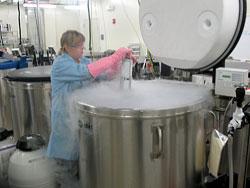
Courtesy of The Jackson Laboratory.
We enter a first-floor room lined with wheeled, metal thermoses that look like industrial garbage bins. Together these fridges contain about 3 million cryopreserved embryos—a library of microscopic mice, each smaller than the width of a human hair, stored at minus-196 degrees Celsius in cocktail straws stopped up with cotton. If I wanted to make a withdrawal, an infant from any of 5,400 mouse lineages could be defrosted, implanted, birthed, and weaned in about 12 weeks.
"I don't remember a time when I didn't know what a liquid nitrogen tank looks like," says Taft. He grew up on a dairy farm in northeast Ohio, and might have spent his life working there if it hadn't been for a wrist injury, the kind that makes it impossible to milk cows. So it was on to plan B, a graduate degree in reproductive biology, and a career spent mastering the nuances of animal IVF. (Here's one: "It's fairly easy to collect semen from a bull, but not always safe.") While Taft's cousins try to kill off the rodents that invade their farms, he's up in Maine making new ones as fast as he can—750,000 embryos added to the archives every year.
Mice get pulled from the archives, too. For the active strains—Black-6 and the others—resuscitation orders come down after every five generations of breeding in the barrier rooms. Taft defrosts a couple of males and females from the metal bin, and sends them over to repopulate the Jackson stock with disco-era genes. It's a matter of applying the efficiencies of industrial cattle farming to laboratory animals, he says. "I've been accused of trying to turn mice into small cows. I like to think we've been fairly successful."
* * *
From its start, the Black-6 was meant to be as reliable as a rubber stamp, but Little had grander aims for his identical, inbred mice. He wanted one kind of animal to stand in for all the others in the lab: A mouse that served as a tiny cow, sure, but also a rabbit, a dog and a monkey. His inbred legions would take the place of humans, too, in the testing of new drugs and treatments for cancer, tuberculosis, and every other disease of man or mammal.
When I finally see one of these tiny humans pulled from a cage by its tail, I don't know if it's a Black-6 from Jackson Lab or Charles River or some other rodent breeder. (Each sells its own version of the standard mouse, differing only by some slight degree of genetic drift.) Wherever it's from, the animal before me is about to be dropped into a large basin filled with milky water, where it will swim around for a few seconds, whipping its tail in a rodent panic, until it finds a platform hidden beneath the surface. Researchers use this setup, called the "Morris Water Maze," to test their mice for signs of cognitive impairment—a rodent analogue, perhaps, of what happens to people with Alzheimer's, Parkinson's, or schizophrenia.
After flopping around the tub for a bit, the mouse arrives at the platform and huddles up like a mini-Koosh with its whiskers twitching. It sits there a while, dopey and nitwitted, a lousy-looking stand-in for a human with his mind on the blink. But then it’s not long before what seemed so mean and pestilent starts to be familiar: a body shivering after a swim, with two eyes, two ears, a nose, and a mouth. The Black-6 has a tongue, too, and a throat and a stomach and a cluster of visceral organs wrapped up with veins and arteries; there are nipples on its chest and nails on its toes. Why shouldn't it stand in for a person?
"The greatest and, perhaps, radical distinction between different men's dispositions for philosophy and the sciences is this," wrote Francis Bacon nearly 400 years ago, "that some are more vigorous and active in observing the differences of things, others in observing their resemblances." The best kind of science emerges from the balance of these dispositions—an approach that begins by analyzing the parts, and then moves on to a theory of the whole. In August 1857, Darwin put things more simply: "It is good to have hair-splitters and lumpers," he declared.
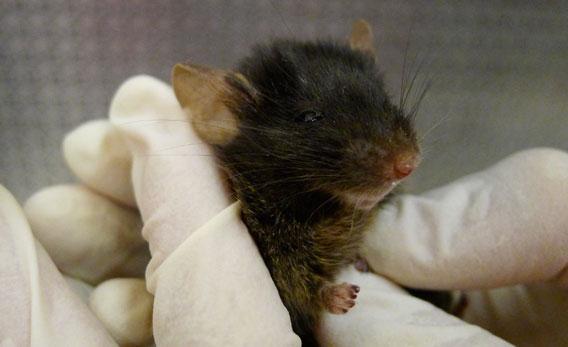
Photograph by Jessie Kotler.
With the rise of the modern lab mouse, the lumpers have come to dominate; their favorite tool was designed from the start to obscure the differences of things and champion their resemblances. Clarence Little began his inbreeding experiments at a time when the old-fashioned modes of hair-splitting—the comparative, exhaustive study of plants and animals—were in rapid decline. Biologists had made an astonishing run of observations about the sameness of things, starting with the discovery, by Theodor Schwann and Matthias Schleiden in the late-1830s, that every plant and animal on Earth comprises a set of cells, Nature's Lego bricks. A growing understanding of how each of these parts functioned revealed that every mammal and microbe might be reducible to a few standard molecules (nucleic acids, proteins, carbohydrates, and so on) interacting in a handful of ways. In 1926, just as Little's inbred lines of C57 mice were beginning to stabilize, a Dutch biochemist named Albert Jan Kluyver captured the lumper's credo in a famous phrase: "From the elephant to butyric acid bacterium—it is all the same!"
But the spread of Black-6 and the other inbred strains ran afoul of another tenet of the scientific method, articulated by one of Little’s contemporaries just as Jackson Lab was being established. In 1929, a physiologist named August Krogh, who’d spent his career studying glass worms, moth pupae, mice, grasshoppers, frogs, and many other species, declared that for many problems, "there will be some animal of choice, or a few such animals on which it can be most conveniently studied." To illustrate his point, he cited a variety of tortoise in which the trachea was unusually divided: "We used to say as a laboratory joke that this animal has been created expressly for the purposes of respiration physiology."
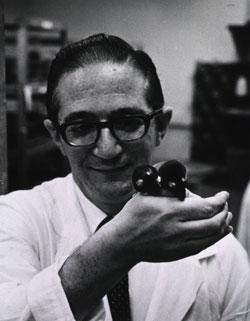
Photograph by Thomas Joy, image from the National Library of Medicine.
It’s an idea that remains current in science. Ask 100 biologists how they choose their animal models and they'll all say the same thing: First, you need to ask the right question, then you need to find the right means for answering that question. Rodent or fly, mouse or rat, Black-6 or Bagg’s Albino—when it comes to tinkering with Nature, there's a tool for every job. That's the rhetoric of modern science—that each experiment should have its most perfect method, a lab animal special to its purpose. We can joke, like Krogh, that the giant axon of the squid was created for the study of neural transmission, or that the optic nerves of the horseshoe crab were designed to be frayed and split for the study of vision, and Krogh's Principle lives on in an array of model species in use today: Armadillos for leprosy, prairie voles for autism, finches for language acquisition, leopard geckos and red-eared slider turtles for sex determination, sea slugs for learning and memory, and many more "animals of choice" for solving one problem or another.
In truth, the armadillos, prairie voles, and the other exotic models live only at the margins of biomedicine. For most questions that arise, the mouse offers at least some kind of a solution. It’s a skeleton key that’s tried at every one of Nature’s doors. If the Black-6 should happen to fall short—if its body or organs turned up wanting for one study or another—then we can tweak its genes until it works. Scientists now put human DNA in mice to make their brains deteriorate as if they had Alzheimer's, or to make their blood more vulnerable to leukemia, or to "humanize" their livers so they metabolize drugs like people do. In July, a team of scientists in Ann Arbor published the first successful implantation of a human anal sphincter into a transgenic rodent, a lab-made mouse with a man's ass that might one day help us find a cure for fecal incontinence. Eighty years ago, scientists could laugh at the idea of an animal created expressly for the lab. Today they do it all the time.
Even as these models proliferate, and new mice are drawn up to fit each field, the raw material remains the same. It may seem like diversity to have all these animals in the lab, so ingeniously devised for one purpose or another. Yet most are made from a common lump of clay. We've tried to turn a young, male alcoholic mouse into whatever we need him to be. He may be the most powerful, flexible organism in the history of biomedicine, but no matter what we do to him, no matter how far we twist his genes, he will always be Black-6.
* * *
Jeff Mogil is a hair-splitter. "People who study behavior are willing to live with more variability," the pain expert says over the phone from his office in Montreal. "It leads to a different mindset. Instead of measuring protein levels, I measure behavior. Sometimes incredibly stupid behaviors, like tail flicks or licks or blinks—but behavior. People who work in biochemistry,” though? They’re “more likely to be lumping."
Mogil has spent much of his career decrying the lumpiness of his field. The adoption of just a few standard animals—Sprague Dawley rats and Black-6 mice—used in a few standard ways has slowed down pain research and left millions of patients without useful drugs. By way of example, he points out that 70 percent of all sufferers of chronic pain are women, and most are middle-aged—yet the lion's share of what we know about the disease comes from juvenile male rodents. It’s a mismatch that has already wasted millions of dollars in failed clinical trials: In October 2002, a company called Endo Pharmaceuticals shut down one of its most promising drugs, MorphiDex, after finding that its remarkable effects in animals failed to translate to people. To Mogil, the problem was clear enough—a classic lumper’s error, repeated over the course of a decade and through a hundred published papers. When he ran his own study of the drug in 2004, he added one tiny wrinkle to make his point: Instead of testing MorphiDex on male Black-6 mice, as most labs would do, he used a combination of males and females. It turned out that Black-6 mice—and maybe rats and humans, too—have gender-specific ways of handling pain: What's accomplished by one receptor in the male seems to be handled by another in the female.
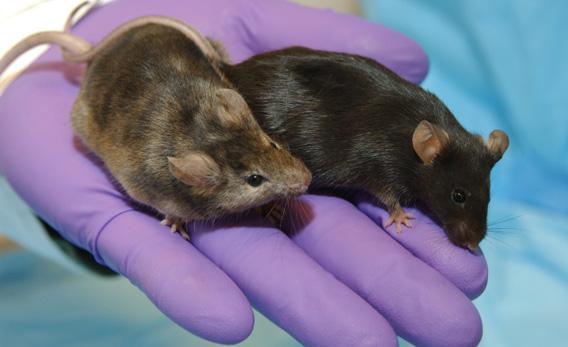
Photograph by Maggie Bartlett, National Human Genome Research Institute.
Several other pain treatments have failed in spectacular ways upon moving from the cage to the clinic. Drugs designed to block substance-P receptors and sodium channels succeeded in rodent models, but had little, if any, effect in people. According to Mogil, there's really just one commercial analgesic for human patients whose efficacy was first identified and tested in animal models—a derivative of cone snail venom called ziconotide—and it's not a particularly good drug.
With the help of transgenic mice, researchers have identified some 300 molecules that may play a role in pain or analgesia—a tenfold increase in potential drug targets since 1990. Yet the process of drug discovery continues to stagnate. The pipeline remains stopped up. "It's the dirty little secret of all of neuroscience," he says.
Mogil doesn't blame Black-6 mice and Sprague Dawley rats for the slow progress, exactly. He's more concerned with the ways in which they're used—the strains and genders, the models and assays, the hot plates and pinched nerves—all the things that yield plenty of data in the lab but may have little to do with what happens in the real world. Over the last decade, he's made a hair-splitter's tour of academic conferences, telling his colleagues that Black-6 mice are different from 129s, that mice are different from rats, that males are different from females, and that rodents are different from humans.
"People pretty much ignored it completely. They said, 'Everything is probably OK,' and they're probably right. I can't prove that anyone's findings are confounded," he says. For his own work, he continues to fax in his orders for Black-6 mice, getting a new box of animals sent over every three weeks from Charles River or Jackson Lab. It's one thing to point out the weaknesses of the method, and another to abandon it altogether. "If you can't beat 'em, join 'em. You can spit at the wind, but if it doesn't work, what are you going to do?"
More from this series: How mouse research could be limiting our knowledge of human disease, and the invincible naked mole-rat. Also, a history of rodent mazes. Read the text-only version of all three parts here.
